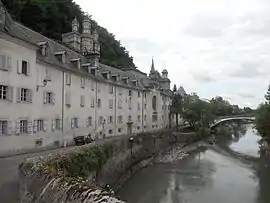Lestelle-Bétharram | |
|---|---|
 General view of the sanctuaries of Bétharram | |
.svg.png.webp) Coat of arms | |
Location of Lestelle-Bétharram | |
 Lestelle-Bétharram  Lestelle-Bétharram | |
| Coordinates: 43°07′51″N 0°12′30″W / 43.1308°N 0.2083°W | |
| Country | France |
| Region | Nouvelle-Aquitaine |
| Department | Pyrénées-Atlantiques |
| Arrondissement | Pau |
| Canton | Vallées de l'Ousse et du Lagoin |
| Intercommunality | Pays de Nay |
| Government | |
| • Mayor (2020–2026) | Jean-Marie Berchon[1] |
| Area 1 | 8.63 km2 (3.33 sq mi) |
| Population | 803 |
| • Density | 93/km2 (240/sq mi) |
| Time zone | UTC+01:00 (CET) |
| • Summer (DST) | UTC+02:00 (CEST) |
| INSEE/Postal code | 64339 /64800 |
| Elevation | 278–481 m (912–1,578 ft) (avg. 294 m or 965 ft) |
| 1 French Land Register data, which excludes lakes, ponds, glaciers > 1 km2 (0.386 sq mi or 247 acres) and river estuaries. | |
Lestelle-Bétharram (French pronunciation: [lɛstɛl betaʁam]; Occitan: L'Estela e Bètharram) is a commune in the Pyrénées-Atlantiques department in south-western France.
History
In 1832, St. Michel Garicoits established the Society of Priests of the Sacred Heart of Betharram.
On 5 July 1940, Carl Einstein, German author, activist, and art critic, committed suicide here. An anarchist veteran of the Spanish Civil War, he had been interned in France after the rebel Nationalist victory. Although he had escaped in the turmoil following the German invasion of France, he chose death as the solution to an impossible situation.[3]

Bétharram near 1840, by Eugène de Malbos.
See also
References
- ↑ "Répertoire national des élus: les maires". data.gouv.fr, Plateforme ouverte des données publiques françaises (in French). 2 December 2020.
- ↑ "Populations légales 2021". The National Institute of Statistics and Economic Studies. 28 December 2023.
- ↑ Lester, David (2005). Suicide and the Holocaust. Nova Publishers. p. 73. ISBN 978-1-59454-427-9.
Wikimedia Commons has media related to Lestelle-Bétharram.
This article is issued from Wikipedia. The text is licensed under Creative Commons - Attribution - Sharealike. Additional terms may apply for the media files.